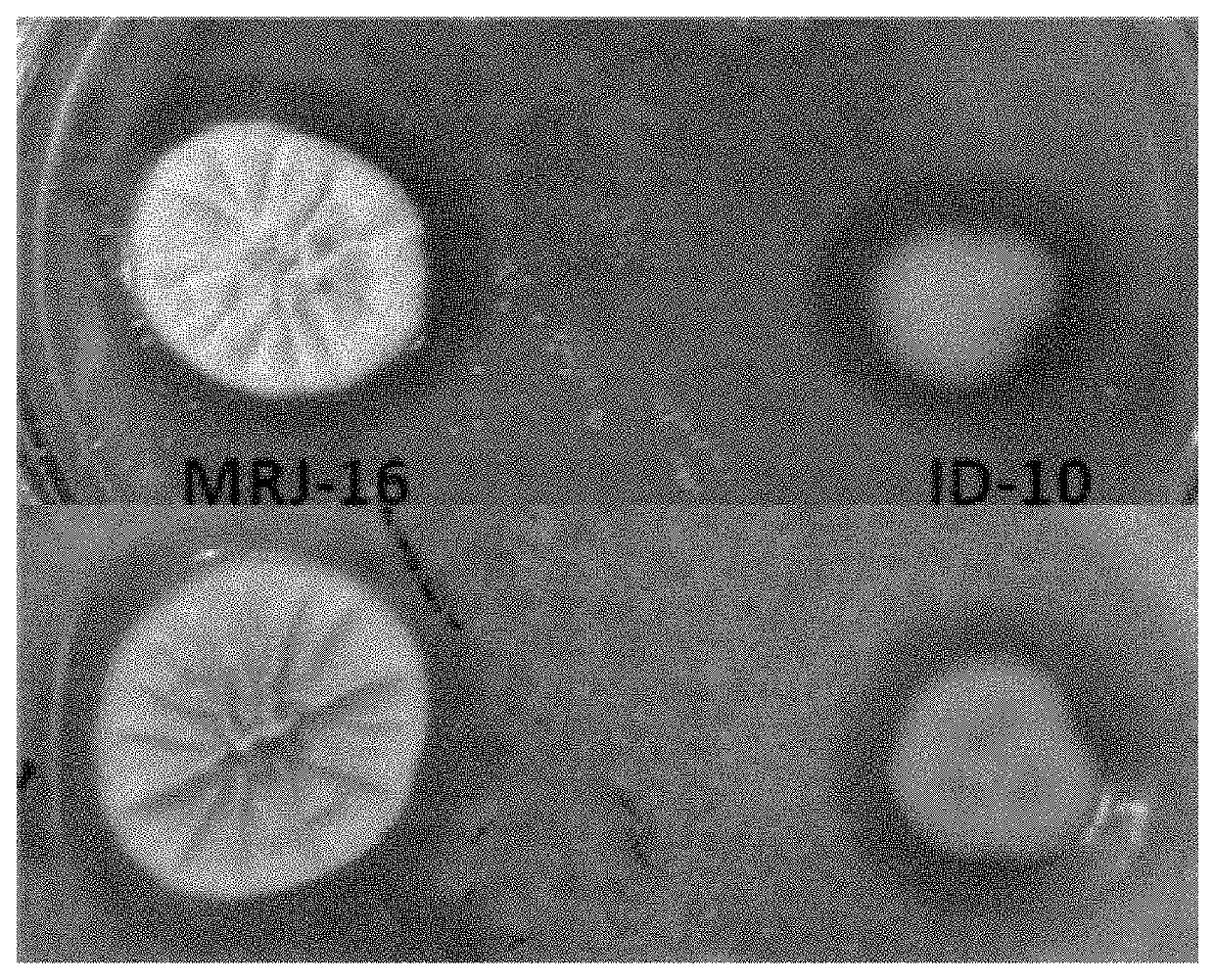Method for preparation of fungal mutant with high hydrolytic activity
a technology of hypercellulolytic catabolite and mutant, which is applied in the field of derepression of hypercellulolytic catabolite mutant, can solve the problems of inability to develop a viable technology in india, high cost of cellulosic ethanol application process, and inability to meet the requirements of biochemical equipment, etc., and achieves the reduction of the effect of reducing the amount of enzyme use for biomass saccharification and the effect of reducing
- Summary
- Abstract
- Description
- Claims
- Application Information
AI Technical Summary
Benefits of technology
Problems solved by technology
Method used
Image
Examples
example no.1
Example No. 1—Screening of an Efficient Mutant for Enzyme Production
[0017]The parent strain Penicillium funiculosum MRJ-16 mutant strain was used to create mutants for enzyme production. Mutations were done using UV or NTG or EMS mutagens alone or all together. The mutant strains were obtained after repeated multistage mutagenesis process. Mutants were selected sequentially on specially designed media containing amorphous cellulose and glucose at different concentration from 1-4% (w / w) (screening media composition in table no. 1). Mutant strain that hydrolyzes the amorphous cellulose in the presence of 4% glucose was selected after visualizing and measuring the hydrolyzed zone. Stability of mutant stain for enzyme production capability was tested for multiple cycles and then used for further study.
[0018]
TABLE NO. 1Screening media compositionS. No.Chemical ComponentsQuantity (g / L)1Ammonium sulphate1.42KH2PO42.03MgSO4•7H2O0.34CaCl2•3H2O0.35Urea0.36Tween-800.17Peptone0.258Yeast Extract...
example no.2
Example No. 2—Enzyme Production Comparison of Mutant ID-10 and MRJ-16 Parent Strains
[0020]Fermentation process was carried out in aerated stirred tank bioreactor of 2 L glass jacketed vessel, with 1.8 L working volume. The media components of fermentation media used were ammonium sulphate 3.5 g / L, KH2PO4 4 g / L, MgSO4.7H2O 0.5 g / L, CaCO3 2.5 g / L, Glycerol 2.5 g / L, Corn steep solids 20 g / L, cellulose 20 g / L and Tween-80 2 ml / L. The fermenter containing 1.5 L medium was sterilized at 120° C. for 20 min. After cooling, the temperature was kept at 30° C., pH adjusted to 5.5 and inoculated with 10% active liquid seed (seed media composition in table no.2) of Penicillium ID-10 mutant strain. After 96 h of fermentation, the enzyme broth was collected, centrifuged and analysis of clear enzyme broth was done.
[0021]
TABLE NO. 2Seed / Inoculum Media compositionS. No.Chemical ComponentsQuantity (g / L)1Ammonium Sulphate42KH2PO433MgSO4•7H2O0.14CaCO325Sucrose56Corn Steep Liquor157Cellulose108Tween-8029...
example no.3
Example No. 3—Enzyme Production Comparison of Mutant ID-10 and MRJ-16 Parent Strains
[0023]Fermentation process was carried out in aerated stirred tank bioreactor of 2 L glass jacketed vessel, with 1.8 L working volume. The media components of fermentation media used were ammonium sulphate 5 g / L, KH2PO4 6 g / L, MgSO4.7H2O 1 g / L, CaCO3 5 g / L, Glycerol 2.5 g / L, Corn steep solids 30 g / L, cellulose 30 g / L and Tween-80 2 ml / L. The fermenter containing 1.5 L medium was sterilized at 120° C. for 20 min. After cooling, the temperature was kept at 30° C., pH adjusted to 5.5 and inoculated with 10% active liquid seed (seed media composition in table no. 3) of Penicillium ID-10 mutant strain. After 96 h of fermentation, the enzyme broth was collected, centrifuged and analysis of clear enzyme broth was done.
[0024]
TABLE NO. 3Seed / Inoculum Media compositionS. No.Chemical ComponentsQuantity (g / L)1Ammonium Sulphate52KH2PO463MgSO4•7H2O14CaCO32.55Sucrose106Corn Steep Liquor107Cellulose208Tween-8029pH5....
PUM
| Property | Measurement | Unit |
|---|---|---|
| volume | aaaaa | aaaaa |
| volume | aaaaa | aaaaa |
| diameter | aaaaa | aaaaa |
Abstract
Description
Claims
Application Information
 Login to View More
Login to View More - R&D
- Intellectual Property
- Life Sciences
- Materials
- Tech Scout
- Unparalleled Data Quality
- Higher Quality Content
- 60% Fewer Hallucinations
Browse by: Latest US Patents, China's latest patents, Technical Efficacy Thesaurus, Application Domain, Technology Topic, Popular Technical Reports.
© 2025 PatSnap. All rights reserved.Legal|Privacy policy|Modern Slavery Act Transparency Statement|Sitemap|About US| Contact US: help@patsnap.com

